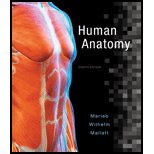
Human Anatomy (8th Edition)
8th Edition
ISBN: 9780134243818
Author: Elaine N. Marieb, Patricia Brady Wilhelm, Jon B. Mallatt
Publisher: PEARSON
expand_more
expand_more
format_list_bulleted
Concept explainers
Question
Chapter 20, Problem 8CRCAQ
Summary Introduction
To review:
1. The reason behind the abundance of varicose veins in the lower limbs of the human body.
2. The functional reason behind the less abundance of valves in the veins of the neck region.
Introduction:
The circulatory system is associated with the transportation of blood to the whole body. The long chain of blood vessels are present throughout the body in order to maintain the proper supply of the blood to different body parts. There are separate vessels for the transportation of oxygenated and deoxygenated blood.
Expert Solution & Answer
Want to see the full answer?
Check out a sample textbook solution
Students have asked these similar questions
glg 112 mid unit assignment Identifying melting processes
Give only the mode of inheritance consistent with all three pedigrees and only two reasons that support this, nothing more, (it shouldn't take too long)
O
Chapter 20 Solutions
Human Anatomy (8th Edition)
Ch. 20 - What structural features of capillaries make them...Ch. 20 - Prob. 2CYUCh. 20 - Prob. 3CYUCh. 20 - Prob. 4CYUCh. 20 - Prob. 5CYUCh. 20 - Prob. 6CYUCh. 20 - Which vessel do you palpate to feel a pulse in...Ch. 20 - Name the vessels that branch off the abdominal...Ch. 20 - Prob. 9CYUCh. 20 - Prob. 10CYU
Ch. 20 - Prob. 11CYUCh. 20 - Prob. 12CYUCh. 20 - How does elevated blood glucose associated with...Ch. 20 - Prob. 14CYUCh. 20 - Prob. 15CYUCh. 20 - Prob. 1RQCh. 20 - Prob. 2RQCh. 20 - Prob. 3RQCh. 20 - Prob. 4RQCh. 20 - Which of the following vessels is bilaterally...Ch. 20 - Prob. 6RQCh. 20 - Prob. 7RQCh. 20 - Prob. 8RQCh. 20 - The following sequence traces the flow of...Ch. 20 - Prob. 10RQCh. 20 - The inferior mesenteric artery supplies the (a)...Ch. 20 - Prob. 12RQCh. 20 - Prob. 13RQCh. 20 - Prob. 14RQCh. 20 - Prob. 15RQCh. 20 - Prob. 16RQCh. 20 - (a) What structural features are responsible for...Ch. 20 - Prob. 18RQCh. 20 - Prob. 19RQCh. 20 - Sketch the arterial circle at the base of the...Ch. 20 - Prob. 21RQCh. 20 - Prob. 22RQCh. 20 - Prob. 23RQCh. 20 - Prob. 24RQCh. 20 - Differentiate between arteriosclerosis and...Ch. 20 - A pulse can be felt in the following arteries:...Ch. 20 - In an eighth-grade health class, the teacher...Ch. 20 - Prob. 2CRCAQCh. 20 - Prob. 3CRCAQCh. 20 - Prob. 4CRCAQCh. 20 - Prob. 5CRCAQCh. 20 - Prob. 6CRCAQCh. 20 - Occasionally, either the ductus arteriosus or the...Ch. 20 - Prob. 8CRCAQ
Knowledge Booster
Learn more about
Need a deep-dive on the concept behind this application? Look no further. Learn more about this topic, biology and related others by exploring similar questions and additional content below.Similar questions
- Describe the principle of homeostasis.arrow_forwardExplain how the hormones of the glands listed below travel around the body to target organs and tissues : Pituitary gland Hypothalamus Thyroid Parathyroid Adrenal Pineal Pancreas(islets of langerhans) Gonads (testes and ovaries) Placentaarrow_forwardWhat are the functions of the hormones produced in the glands listed below: Pituitary gland Hypothalamus Thyroid Parathyroid Adrenal Pineal Pancreas(islets of langerhans) Gonads (testes and ovaries) Placentaarrow_forward
- Describe the hormones produced in the glands listed below: Pituitary gland Hypothalamus Thyroid Parathyroid Adrenal Pineal Pancreas(islets of langerhans) Gonads (testes and ovaries) Placentaarrow_forwardPlease help me calculate drug dosage from the following information: Patient weight: 35 pounds, so 15.9 kilograms (got this by dividing 35 pounds by 2.2 kilograms) Drug dose: 0.05mg/kg Drug concentration: 2mg/mLarrow_forwardA 25-year-old woman presents to the emergency department with a 2-day history of fever, chills, severe headache, and confusion. She recently returned from a trip to sub-Saharan Africa, where she did not take malaria prophylaxis. On examination, she is febrile (39.8°C/103.6°F) and hypotensive. Laboratory studies reveal hemoglobin of 8.0 g/dL, platelet count of 50,000/μL, and evidence of hemoglobinuria. A peripheral blood smear shows ring forms and banana-shaped gametocytes. Which of the following Plasmodium species is most likely responsible for her severe symptoms? A. Plasmodium vivax B. Plasmodium ovale C. Plasmodium malariae D. Plasmodium falciparumarrow_forward
- please fill in missing parts , thank youarrow_forwardplease draw in the answers, thank youarrow_forwarda. On this first grid, assume that the DNA and RNA templates are read left to right. DNA DNA mRNA codon tRNA anticodon polypeptide _strand strand C с A T G A U G C A TRP b. Now do this AGAIN assuming that the DNA and RNA templates are read right to left. DNA DNA strand strand C mRNA codon tRNA anticodon polypeptide 0 A T G A U G с A TRParrow_forward
arrow_back_ios
SEE MORE QUESTIONS
arrow_forward_ios
Recommended textbooks for you
 Medical Terminology for Health Professions, Spira...Health & NutritionISBN:9781305634350Author:Ann Ehrlich, Carol L. Schroeder, Laura Ehrlich, Katrina A. SchroederPublisher:Cengage LearningBasic Clinical Lab Competencies for Respiratory C...NursingISBN:9781285244662Author:WhitePublisher:Cengage
Medical Terminology for Health Professions, Spira...Health & NutritionISBN:9781305634350Author:Ann Ehrlich, Carol L. Schroeder, Laura Ehrlich, Katrina A. SchroederPublisher:Cengage LearningBasic Clinical Lab Competencies for Respiratory C...NursingISBN:9781285244662Author:WhitePublisher:Cengage Human Physiology: From Cells to Systems (MindTap ...BiologyISBN:9781285866932Author:Lauralee SherwoodPublisher:Cengage Learning
Human Physiology: From Cells to Systems (MindTap ...BiologyISBN:9781285866932Author:Lauralee SherwoodPublisher:Cengage Learning

Medical Terminology for Health Professions, Spira...
Health & Nutrition
ISBN:9781305634350
Author:Ann Ehrlich, Carol L. Schroeder, Laura Ehrlich, Katrina A. Schroeder
Publisher:Cengage Learning

Basic Clinical Lab Competencies for Respiratory C...
Nursing
ISBN:9781285244662
Author:White
Publisher:Cengage

Human Physiology: From Cells to Systems (MindTap ...
Biology
ISBN:9781285866932
Author:Lauralee Sherwood
Publisher:Cengage Learning


